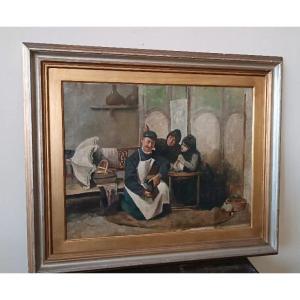Perfect condition ready to place.
Part of a pair sold separately.
Biography
His father, Barthélemy Verboeckhoven [nl], was a sculptor and his older brother, Eugène, was an animal painter, both of whom provided him with early artistic training. In 1815, the family moved to Ghent, where he developed an interest in marine painting and came under the influence of Frans Balthasar Solvyns.
In 1827, together with his father and brother, he settled in Brussels and, that same year, exhibited two paintings ("Angry Sea" and "Calm Sea") at the local Salon. His work gained immediate popularity. In 1830, however, he abandoned painting, to become involved in the political events that led to Belgian independence. He and Eugène both joined the "Korps Jagers van Chasteler" (named after Johann Gabriel Chasteler de Courcelles) and participated in several military actions during the Revolution.
Afterwards, his life was essentially a succession of exhibitions, including the "Triennial Salons" in Brussels, Ghent and Antwerp and smaller salons in the provinces; punctuated by frequent trips to the coasts of the Netherlands, France and England. In 1837, he appears to have been living in Antwerp. Afterwards, he concentrated on selling his paintings abroad.
After 1842, he used brighter colors and his style became more realistic. Most often, the foreground figures were provided by his brother, who reportedly performed the same service for several well-known landscape painters. Many of his works are set in small ports along the Scheldt, which have since disappeared and cannot be identified with certainty.
Towards the end of his career, he was made a member of the Rijksakademie. His son, Louis (1827-1884), was also a painter.

















































 Le Magazine de PROANTIC
Le Magazine de PROANTIC TRÉSORS Magazine
TRÉSORS Magazine Rivista Artiquariato
Rivista Artiquariato